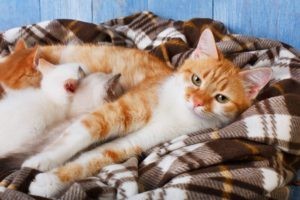Cats communicate in fascinating ways, and one of the most endearing is “making biscuits,” also known as kneading. This behavior, where a cat rhythmically pushes their paws into soft surfaces, often accompanied by purring, raises a common question: why do cats make biscuits? This article explores the various reasons behind this intriguing feline habit.
The Origins of Biscuit Making: Kittenhood and Instinct
Kneading originates in kittenhood. Newborn kittens instinctively knead their mother’s mammary glands to stimulate milk flow. This action is associated with feelings of nourishment, comfort, and security. The pleasurable association formed in these early weeks often carries over into adulthood. As a result, adult cats may continue to knead as a way to self-soothe or express contentment.
Comfort, Contentment, and Showing Affection
Kneading often signifies a cat’s feeling of deep relaxation and happiness. When your cat makes biscuits on your lap, it’s a sign of affection and trust. They’re recreating the comforting sensation of nursing and expressing their bond with you. The intensity of the kneading can even indicate the depth of their affection – the harder they knead, the more they adore you! While this can sometimes be a little painful due to their claws, it’s a gesture of love worth enduring (with regular nail trims, of course!).
Nesting Instincts and Preparing for Sleep
Cats also knead as a way to prepare a comfortable sleeping spot. This behavior stems from their wild ancestors, who would flatten down grass or foliage to create a cozy nest. Domestic cats may exhibit this instinct by kneading blankets, pillows, or even your clothing before settling down for a nap. It’s their way of creating a safe and comfortable environment for relaxation.
Scent Marking and Territorial Behavior
Cats have scent glands in their paws that release pheromones, unique chemical signals that communicate information to other cats. When a cat kneads, they’re depositing these pheromones, marking their territory and claiming ownership of the object or person they’re kneading. This behavior is a subtle way of communicating their presence and establishing their domain within the household.
Stretching and Circulation
Kneading can also serve as a form of stretching for cats. The rhythmic pushing and pulling motion helps to extend and flex their muscles, particularly after periods of inactivity. This stretching promotes blood flow and helps to keep their muscles limber and ready for action.
Kneading During Heat and Labor
Female cats may exhibit increased kneading behavior when they’re in heat. This action, often accompanied by purring and rolling, signals their receptiveness to mating. Similarly, pregnant cats may knead as they prepare a nest for their impending kittens. This nesting behavior often intensifies as labor approaches.
Conclusion: Decoding Your Cat’s Biscuits
Cats make biscuits for a variety of reasons, ranging from instinctive comfort-seeking to communication and territorial marking. Understanding these underlying motivations allows us to better appreciate this unique feline behavior and strengthen our bond with our furry companions. While kneading is typically a normal and harmless behavior, consult with a veterinarian if you notice any sudden changes in your cat’s kneading habits, as it could potentially indicate an underlying medical issue.

